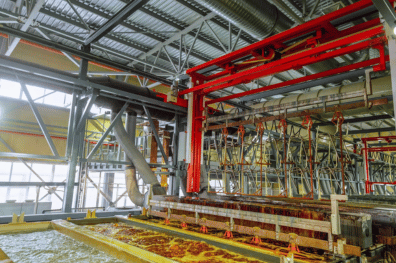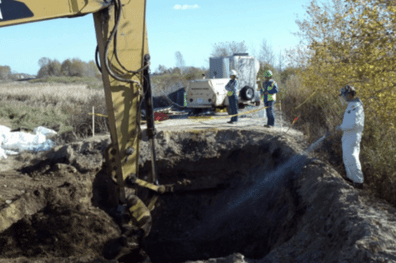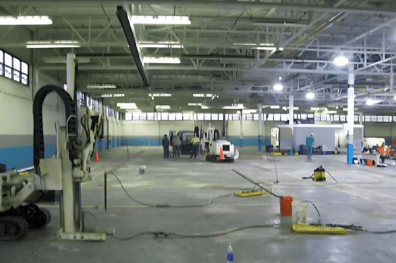ORIN successfully treated highly contaminated groundwater by injecting a solution of Sodium dithionite and Ferrous sulfate. The average depth to groundwater is 6 to 10 ft. The site experienced historically fluctuating levels of hexavalent chromium between 3,750 ppb and 44,600 ppb in the most impacted well (MW-7R). 250 gallons of treatment chemistry solution was injected into each of 18 drilled injection wells. The equipment and workspace were staged and conducted inside the facility. Minor daylighting was experienced and contained. Of the impacted 48,127 ft2 pre-treatment plume area, as designated by values in exceedance of 100 ppb, two source areas were identified. The remedial activities were focused around these source areas.
The Challenge
The site presented complex contamination issues:
- Hexavalent Chromium Levels:
- Average concentration: 11,700 ppb
- Historical fluctuations: 3,750 to 44,600 ppb in MW-7R
- Contaminated area: 48,127 ft²
- Shallow groundwater (6-10 ft depth)
- Two distinct source areas identified
- Silty sand geological matrix
- Indoor treatment requirements
The Solution: Targeted Chemical Treatment
The remediation team implemented a strategic approach:
- Treatment Chemistry:
- Combined sodium dithionite and ferrous sulfate solution
- 250 gallons per injection point
- 18 drilled injection wells
- Total treatment volume: 4,500 gallons
- Implementation Strategy:
- Indoor workspace setup
- Focused treatment around source areas
- Controlled injection process
- Successful containment of minor daylighting
Two-Year Results
The treatment achieved significant improvements:
- 89% reduction in total hexavalent chromium
- 44% decrease in plume area exceeding 100 ppb
- Successful treatment across most monitoring wells
- One exception: MW-7R showed rebound, revealing previously unknown hotspots
Key Insights
Several important findings emerged:
- Treatment Effectiveness:
- High success rate in treated areas
- Significant plume reduction
- Long-term stability in most locations
- Site Understanding:
- Revealed previously unknown hotspots
- Improved understanding of contamination distribution
- Identified areas needing additional treatment
Technical Innovations
The project demonstrated several notable approaches:
- Indoor remediation capabilities
- Effective chemical combination for chromium treatment
- Strategic well placement
- Successful containment methods
Lessons Learned
Key takeaways from the project:
- Importance of long-term monitoring
- Value of comprehensive site characterization
- Need for flexible treatment strategies
- Benefits of focused source area treatment
This case study provides valuable insights for similar chromium remediation projects, particularly those dealing with industrial facilities and multiple source areas.



